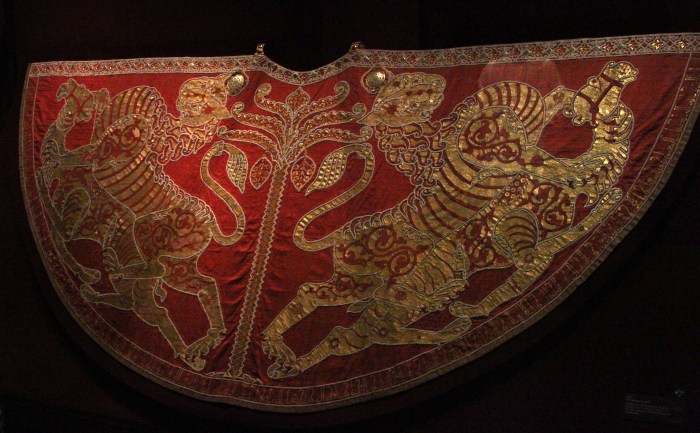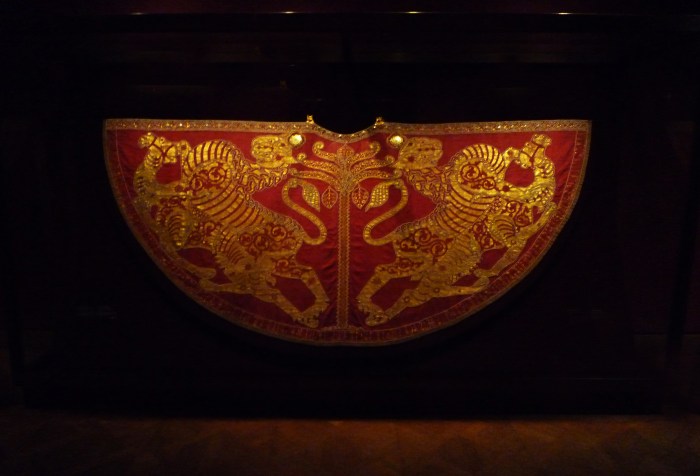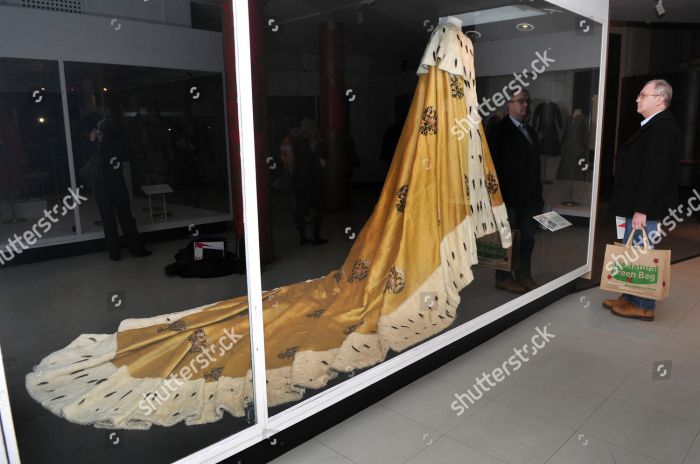The Coronation Mantle of Roger II, a magnificent artifact from Norman Sicily, stands as a testament to the grandeur and ambition of its royal patron. Embroidered with intricate scenes from the Bible and adorned with precious stones, this exquisite garment embodies the political and religious significance of the Norman conquest of Sicily.
This remarkable mantle offers a glimpse into the cultural and artistic landscape of Norman Sicily, revealing the complex interplay of power, faith, and artistic expression that characterized this fascinating period.
Historical Context

The coronation mantle of Roger II holds immense significance in the context of Norman rule in Sicily. It symbolizes the establishment of the Kingdom of Sicily and the ambition of Roger II to create a powerful and centralized monarchy.The Norman conquest of Sicily began in 1061 and culminated in the establishment of the Kingdom of Sicily in 1130. Roger II, the first King of Sicily, played a pivotal role in consolidating Norman power and expanding the kingdom’s influence.
He sought to establish a strong and centralized monarchy, inspired by the Byzantine and Islamic models of governance.
Establishment of the Kingdom of Sicily
The establishment of the Kingdom of Sicily marked a significant turning point in the history of the island. The Normans brought with them their own customs, laws, and administrative systems, which blended with the existing Byzantine and Arabic influences to create a unique and vibrant culture.
Roger II played a key role in shaping this new kingdom, promoting religious tolerance and encouraging economic growth.
Roger II’s Ambition
Roger II was a visionary ruler with a grand ambition to create a powerful and centralized monarchy. He saw himself as the heir to the Byzantine emperors and sought to emulate their grandeur and authority. The coronation mantle, with its intricate embroidery and opulent materials, was a physical manifestation of his aspirations and served as a symbol of his royal power.
The coronation mantle of Roger II is a stunning piece of art that showcases the intricate craftsmanship of its time. For those seeking insights into this historical artifact, you may find the bert rodgers exam 23a answers helpful. This resource offers valuable information that can enhance your understanding of the mantle’s significance and the historical context surrounding its creation.
Description of the Mantle

The coronation mantle of Roger II is a magnificent and imposing garment that reflects the power and authority of the Norman king. Measuring approximately 4.5 meters in length and 2.5 meters in width, it is made of a rich silk fabric known as samite, which is woven with gold threads to create intricate patterns.
The mantle is adorned with numerous pearls, precious stones, and gold appliqués, adding to its opulent appearance.
Symbolism and Iconography
The mantle is decorated with a series of embroidered scenes depicting biblical events and figures. These include scenes from the Old Testament, such as the Creation of the World and the story of Adam and Eve, as well as scenes from the New Testament, such as the Nativity and the Crucifixion.
The inclusion of these scenes reflects the Christian faith of Roger II and his desire to legitimize his rule through religious authority.
Artistic Style and Techniques
The mantle is a masterpiece of medieval craftsmanship, showcasing the artistic skills of the Sicilian workshops that produced it. The embroidery is executed in a Byzantine style, with fine and delicate stitches that create a rich and textured effect. The use of gold threads and appliqués adds to the luxurious appearance of the mantle, making it a symbol of the wealth and power of the Norman kingdom.
Symbolism and Meaning: Coronation Mantle Of Roger Ii

The coronation mantle of Roger II was not merely a garment; it was a powerful symbol of his authority and legitimacy as a ruler. Through its elaborate imagery and iconography, the mantle conveyed a complex message about Roger’s claims to power and his desire to be recognized as a legitimate sovereign.
Roger II’s Claims to Authority
The mantle depicts Roger II seated on a throne, holding a scepter and an orb, symbols of royal power. The throne is flanked by two lions, representing strength and authority. The image of Roger as a powerful and legitimate ruler is further reinforced by the presence of the archangels Michael and Gabriel, who stand behind him, offering their protection and support.
Divine Right of Kings
The mantle also reflects Roger’s belief in the divine right of kings. The image of Roger being crowned by Christ suggests that his authority comes directly from God. This belief was common among medieval rulers, who saw themselves as God’s representatives on Earth.
The mantle’s depiction of Roger as a divinely ordained ruler served to legitimize his rule and strengthen his authority.
Royal Power and Majesty
Beyond its political and religious significance, the mantle also served as a symbol of Roger’s royal power and majesty. The rich fabrics, intricate embroidery, and precious jewels used in its creation conveyed a sense of opulence and grandeur. The mantle was a visible representation of Roger’s wealth and status, and it helped to project an image of him as a powerful and respected ruler.
Cultural and Artistic Significance

The coronation mantle of Roger II held immense cultural and artistic significance within the context of Norman Sicily. It represented the culmination of Norman artistic traditions, Byzantine influences, and Islamic motifs, creating a unique and visually stunning masterpiece.
The mantle’s elaborate iconography and symbolism reflected the Norman rulers’ aspirations of power, legitimacy, and divine authority. It became a symbol of the Norman kingdom and its cultural identity, showcasing the blending of different artistic styles that characterized the period.
Influence on Other Works of Art, Coronation mantle of roger ii
The coronation mantle had a profound influence on other works of art created during the Norman period in Sicily. Its distinctive style and iconography can be seen in various artifacts, including mosaics, paintings, and sculptures.
- The mosaics in the Cappella Palatina in Palermo, commissioned by Roger II, feature similar depictions of Christ and the saints, showcasing the influence of the mantle’s iconography.
- The sculptures adorning the portals of the Monreale Cathedral exhibit a blend of Norman and Byzantine styles, reminiscent of the mantle’s eclectic artistic heritage.
Shaping the Visual Culture
The coronation mantle played a significant role in shaping the visual culture of Norman Sicily. Its iconography and artistic style became a standard for other works of art, creating a cohesive and recognizable visual language throughout the kingdom.
The mantle’s influence extended beyond Sicily, influencing artistic developments in other parts of Europe. It became a testament to the cultural and artistic vitality of Norman Sicily, showcasing the kingdom’s unique blend of influences and its contribution to the broader medieval art world.
Conservation and Restoration

The coronation mantle of Roger II has undergone several conservation and restoration efforts to preserve its delicate and historically significant nature. The challenges involved in preserving such an artifact include its age, fragility, and the materials used in its construction.
The mantle has been treated with various techniques to stabilize and protect its structure, including cleaning, reweaving, and reinforcement. Conservators have also used advanced imaging techniques to assess the condition of the mantle and identify areas that require attention.
Challenges in Preserving the Mantle
- Age and Fragility:The mantle is over 800 years old and has been subjected to wear and tear over the centuries. Its delicate fabrics and intricate embroidery are susceptible to damage from handling, light, and environmental factors.
- Materials:The mantle is made of silk, gold thread, and pearls, which are all materials that are prone to deterioration over time. Silk can become brittle, gold thread can tarnish, and pearls can lose their luster.
Despite these challenges, the conservation and restoration efforts have been successful in preserving the mantle for future generations. The mantle is now housed in a climate-controlled environment and is regularly monitored to ensure its condition.
Popular Questions
What is the significance of the Coronation Mantle of Roger II?
The mantle was commissioned by Roger II, the first King of Sicily, as a symbol of his authority and legitimacy. It was worn during his coronation and other important ceremonies.
What are the materials and techniques used in the mantle?
The mantle is made of silk and embroidered with gold thread, pearls, and precious stones. The embroidery depicts scenes from the Old and New Testaments, as well as images of Roger II and his court.
Where is the Coronation Mantle of Roger II currently located?
The mantle is currently housed in the Palazzo Reale in Palermo, Sicily.
